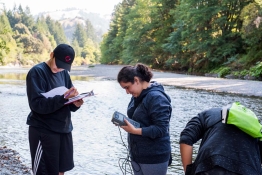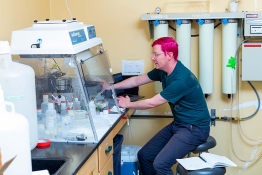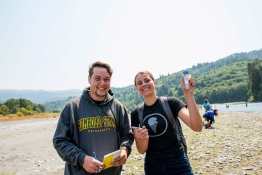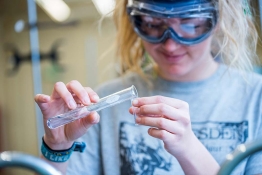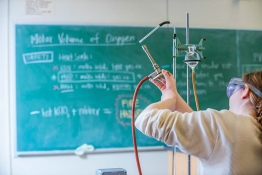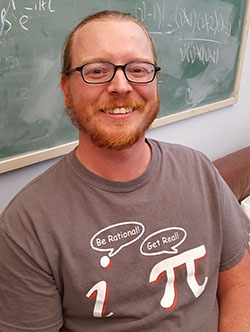11. André, John S.*; Eskandary, Natalie*; Franklin, Terry*; McCann, Emilia J*.; Pascual-Diaz, Oscar*; Pitch, Gregory M.*; Rincon, Jesus D.*; Wright, Megan N.*; and Harmon, Christopher W. (2020) "Preliminary Quantitative and Qualitative Investigations on the Heterogeneous, Irreversible Uptake of Acetone by Titanium(IV) Oxide," IdeaFest: Interdisciplinary Journal of Creative Works and Research from Humboldt State University: Vol. 4 , Article 6. Available at:
https://digitalcommons.humboldt.edu/ideafest/vol4/iss1/610. Gregory M. Pitch*, John S. Andre*, Arion J. Davie*, Christopher W. Harmon, “Investigations of Water Uptake on Sodium Acetate Trihydrate And Nonhydrate as Model Aerosol Surfaces Using the DRIFTS and ATR-FTIR Techniques”, Proceedings of the National Conference for Undergraduate Research (NCUR), 2015, Eastern Washington University, Cheney, WA
9. Cody Hill*, Andreas Geyer*, Cody Tripp*, Christopher W. Harmon, “Development of a Multi-purpose Electrospray,-Electron Impact Tandem Mass Spectrometer,” Proceedings of the National Conference for Undergraduate Research (NCUR), 2014, University of Kentucky, Lexington, KY
8. Christopher W. Harmon, Christopher R. Ruehl, Christopher D. Cappa, and Kevin R. Wilson, “ A Statistical Description of the Evolution of Cloud Condensation Nuclei Activity During the Heterogeneous Oxidation of Squalane and Bis(2-ethylhexly) sebacate aerosol by Hydroxyl Radicals,” Phys. Chem. Chem. Physics 2013 DOI: 10.1039/C3CP50347J
7. Amanda C. MacMillan, John B. Morrison, Christopher W. Harmon, and Sergey A. Nizkorodov, "Enhancement of Surfactants in Nanoparticles Produced by an Electrospray Aerosol Generator” Aero. Sci. & Tech., 2012, 46 (11), 1239-1245
6. Christine J. Koh, Chen-Lin Liu, Christopher W. Harmon, Daniel Strasser, Amir Golan, Oleg Kostko, Steven D. Chambreau, Ghanshyam L.Vaghjiani, and Stephen R. Leone, “Soft Ionization of Thermally Evaporated Hypergolic Ionic Liquid Aerosols,” J. Phys. Chem. A. 2011, DOI:10.1021/jp200633b,
5. Christopher W. Harmon, Ronald L. Grimm, Theresa M. McIntire, Mark D. Peterson, Bosiljka Njegic, Vanessa M Angel, Ahmad Alshawa, Joelle S. Underwood, Douglas J. Tobias, R. Benny Gerber, Mark S. Gordon, John C. Hemminger, and Sergey A. Nizkorodov, “Hygroscopic Growth and Deliquescence of NaCl Nanoparticles Mixed with Surfactant SDS,” J. Phys. Chem. B 2010, 114, 2435-2449
4. Christopher W. Harmon, Steve A. Mang, John Greaves and Barbara J. Finlayson-Pitts, “Identification of Fatty Acids, Phospholipids, and Their Oxidation Products using Matrix Assisted Laser Desorption Ionization Mass Spectrometry andv Electrospray Ionization Mass Spectrometry,” J. Chem. Ed. 2010, vol. 87 No. 2, 186-189
3. Ahmad Alshawa, Otto Dopfer, Christopher W. Harmon, Sergey A. Nizkorodov and Joelle S. Underwood “Hygroscopic Growth and Deliquescence of NaCl Nanoparticles Coated with Surfactant AOT,” J. Phys. Chem. A. 2009, 113. 7678-7686
2. Yong Yu, Michael J. Ezell, Alla Zelenyuk, Dan Imre, Liz Alexander, John Ortega, Barbara D'Anna, Chris W. Harmon, Stanley N. Johnson and Barbara J. Finlayson-Pitts “Photooxidation of α-pinene at High Relative Humidity in the Presence of Increasing Concentrations of NOx” Atmos. Envirn. 2008, DOI: 10.1016/j.atmosenv
1. Yong Yu, Michael J. Ezell, Alla Zelenyuk, Dan Imre, Liz Alexander, John Ortega, Jennie L. Thomas, Karun Gogna, Douglas J. Tobias, Barbara D'Anna, Chris W. Harmon, Stanley N. Johnson and Barbara J. Finlayson-Pitts “Nitrate Ion Photochemistry at Interfaces: A New Mechanism for Oxidation of α-pinene,” Phys. Chem. Chem. Physics 2008, DOI: 10.1039/b719495a
